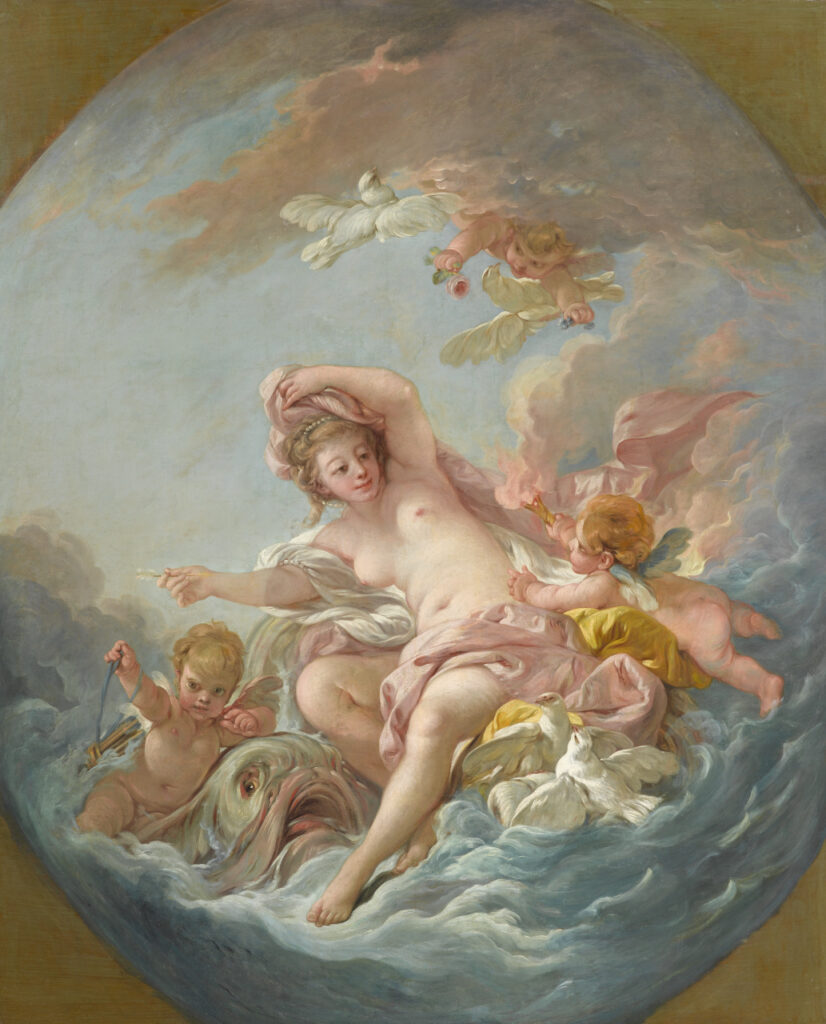Venus Rising from the Waves (work of art)
Artwork Info
Key Ideas
- This oil painting depicts Venus, the goddess of love in Roman mythology. This is an example of a mythological motif (a recurring subject, theme, or idea) in art. Mythological motifs were common in academic art.
- François Boucher was a French painter best known for creating paintings in the rococo style. This French style of art and design began in the early 18th century. It is associated with the aristocracy (ruling social class).
- Boucher was a favorite painter of King Louis XV. His royal patronage gave him greater access to professional opportunities.
- This painting was originally a design for a tapestry at a royal factory in Paris. Boucher was the factory’s art director.
- The color red has long been associated with love. We literally turn red when we blush due to the extra blood flow in our face and skin. Venus, the Roman goddess of love, is depicted in this painting as a blushing young woman.
Learn More
François Boucher was a French painter during the 18th century. He is known for his paintings that depict classical themes, decorative allegories, and pastoral scenes. He was a well-known figure in rococo painting. This French style of art and design began in the early 18th century. It is generally associated with the aristocracy, or ruling social class. Rococo painters were known for making their subjects look graceful and elegant.
Venus is the goddess of love in Roman mythology. Classical mythology and themes of love were popular among Boucher’s upper-class French patrons. Mythological motifs were common in academic art. Academic art was produced under the influence of the official European academies of art. These academies controlled most of the art world from the 17th century through the 19th century. The academies were centers for teaching and exhibiting. They often controlled which artists received patronage. Boucher was a favorite painter of King Louis XV and his mistress Madame de Pompadour. Throughout history royal patronage was important to artists. It gave them access to professional and commercial opportunities. King Louis XV appointed Boucher director of the Gobelins Manufactory, a tapestry factory in Paris. He later promoted Boucher to First Painter to the King.
This painting was originally a design for a tapestry at the royal Gobelins Manufactory. The tapestry factory was founded by the Gobelins brothers in the 15th century. In 1662 King Louis XIV took over the property to create a royal factory. Weavers, painters, bronze workers, furniture makers, goldsmiths, and engravers were hired to work at the factory. The goal was to create a royal factory of furniture and to cover the walls of Versailles with tapestries. Establishing royal factories allowed Louis XIV to stimulate the economy and provide furnishings for his residences. The Gobelins Manufactory was known for its high-quality tapestries. It is said that Louis XIV had more than 2,600 tapestries in his collection.
The color red has been associated with love throughout history. Our symbols for love are universally colored red. We use red hearts for Valentine’s Day. In the language of flowers, red roses represent love and passion. When we blush we turn red due to the extra blood flow in our face and skin. Blushing can be a reaction to a strong emotion, physical exertion, and attraction. In this painting the Roman goddess of love is depicted as a young woman who appears to be blushing.
Additional Resources
Resources for Teachers
- Read the artist’s biography.
- Read an article about academic art.
- Read an article about the Gobelins Manufactory.
- Explore a resource about the symbolism of the color red in art.
Resources for Students
- Watch a video about tapestry making at the Gobelins Manufactory.
- Watch a short video about the Rococo art movement.
- View another work by Boucher.
Images
-

Venus Rising from the Waves
An oil painting of a nude woman sitting on a blue wave. There is a blue sky filled with white and pink clouds behind her. She has light-colored hair and is draped with white and light pink sheets. She is surrounded by three small cupid figures with wings. One cupid is above her in the sky. It holds pink roses in its hand, and a white dove flies beside it. The cupid to the right of the woman holds a flaming gold torch and has two white doves flying beside it. The cupid to the left of the woman holds a bow and arrows. It sits on a sea creature with a doglike face.
